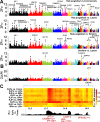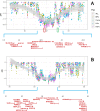Genetics of adaptation in modern chicken
- PMID: 31034467
- PMCID: PMC6508745
- DOI: 10.1371/journal.pgen.1007989
Genetics of adaptation in modern chicken
Abstract
We carried out whole genome resequencing of 127 chicken including red jungle fowl and multiple populations of commercial broilers and layers to perform a systematic screening of adaptive changes in modern chicken (Gallus gallus domesticus). We uncovered >21 million high quality SNPs of which 34% are newly detected variants. This panel comprises >115,000 predicted amino-acid altering substitutions as well as 1,100 SNPs predicted to be stop-gain or -loss, several of which reach high frequencies. Signatures of selection were investigated both through analyses of fixation and differentiation to reveal selective sweeps that may have had prominent roles during domestication and breed development. Contrasting wild and domestic chicken we confirmed selection at the BCO2 and TSHR loci and identified 34 putative sweeps co-localized with ALX1, KITLG, EPGR, IGF1, DLK1, JPT2, CRAMP1, and GLI3, among others. Analysis of enrichment between groups of wild vs. commercials and broilers vs. layers revealed a further panel of candidate genes including CORIN, SKIV2L2 implicated in pigmentation and LEPR, MEGF10 and SPEF2, suggestive of production-oriented selection. SNPs with marked allele frequency differences between wild and domestic chicken showed a highly significant deficiency in the proportion of amino-acid altering mutations (P<2.5×10-6). The results contribute to the understanding of major genetic changes that took place during the evolution of modern chickens and in poultry breeding.
Conflict of interest statement
The authors have declared that no competing interests exist.
Figures




Comment in
-
No "doom" in chicken domestication?PLoS Genet. 2019 May 30;15(5):e1008089. doi: 10.1371/journal.pgen.1008089. eCollection 2019 May. PLoS Genet. 2019. PMID: 31145731 Free PMC article. No abstract available.
References
-
- Darwin C. The variation of animals and plants under domestication. London: John Murray. C; (1868)
-
- Brooke M. & Birkhead T. The Cambridge Encyclopedia of Ornithology. Cambridge University Press, Cambridge: 362pp (1991).
-
- FAOSTAT. FAOSTAT Database. Available online at: http://faostat.fao.org/site (2013).
-
- Most PJ van der, Jong B de, Parmentier HK, Verhulst S. Trade-off between growth and immune function: a meta-analysis of selection experiments. Func. Ecol. 2011;25: 74–80. 10.1111/j.1365-2435.2010.01800.x - DOI
Publication types
MeSH terms
LinkOut - more resources
Full Text Sources
Miscellaneous

